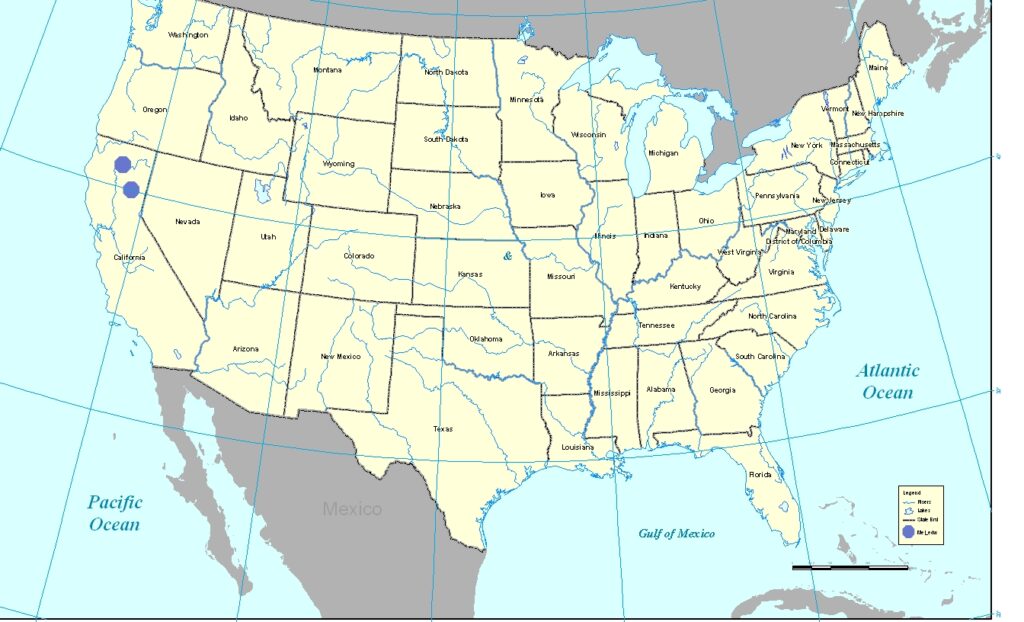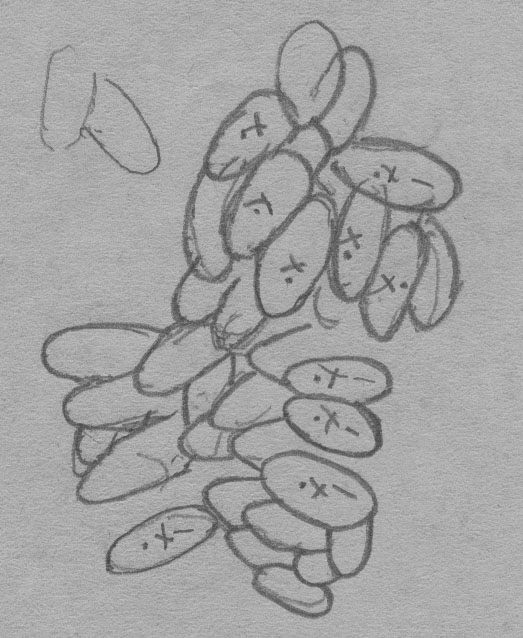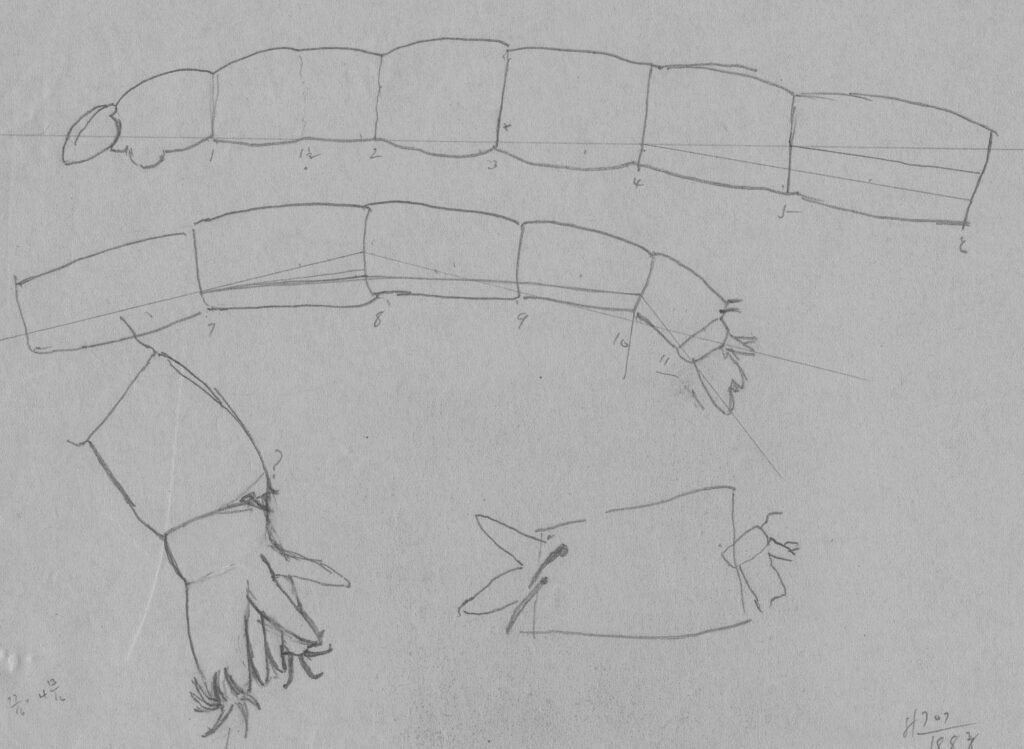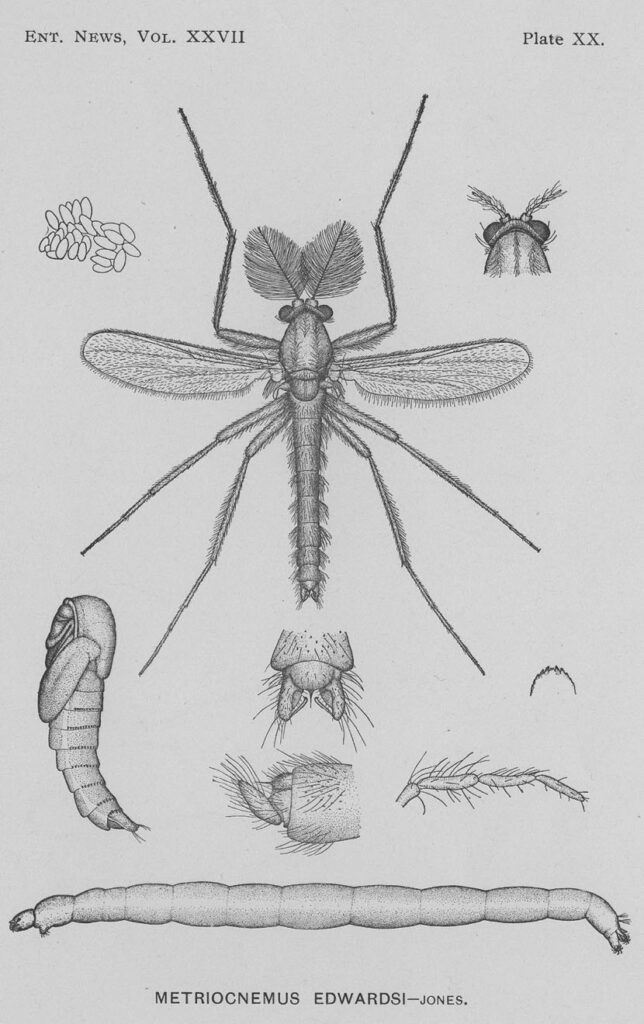From “Two Insect Associates of the California Pitcher Plant Darlingtonia californica,” and unpublished notes by Frank Morton Jones
Locality (See Map)
- Mount Eddy, near Sisson, Siskiyou County, California;
- Edwards: Vicinity of Mt. Shasta, California
- Austin: Plumas County, California

Food
Insect captures of Darlingtonia californica
… The presence of larvae of edwardsi in almost every suitable leaf of Darlingtonia containing insect remains indicates that its association with this plant, like that of knabi with purpurea, is habitual, and possibly exclusive.”
Description
“…[M. edwardsi] proves to be closely related to Metriocnemus knabi Coq., the almost invariable associate of Sarracenia purpurea, differing but little in the imago, but as might be anticipated presenting more evident structural divergence in the larva and pupa; for the water-filled leaf of purpurea offers to the early stages of knabi a habitat almost strictly aquatic, whereas the new species, which may be called Metiocnemus edwardsi, seems perfectly at home among the insect remains in Darlingtonia as long as they are even slightly moist, and its pupal stage is passed, not as by knabi enclosed in a watery welt-like gelatinous mass on the inner wall of the pitcher, but (in captivity) outside the leaf, naked and loosely adherent to the moist basal portion of the plant or in the adjacent moss, over which it wriggles actively when disturbed.

Egg – Approximately circular in cross section, elongated, slightly more pointed at one end, clear pale yellow in color, of smooth and somewhat polished texture; length 0.22mm; cross diameter 0.11mm; deposited in a strongly adherent irregular mass; examined and measured at 100x.

Larva – Slender, almost cylindrical; smooth, pale, but darker than knabi and of a decidedly brownish rather than yellow-white tone; head darker, tending toward pale ferruginous; eye-spots black, prominent, sub-oval, not so obviously formed by the fusion of two spots as in knabi; antennae inconspicuous, shorter than in knabi; mandibles and labium dark brown, the former with five teeth proportional as in knabi, the latter with a single pair of small teeth medially (not two pairs as in knabi) followed by a series of larger ones; claws of anterior and posterior prolegs yellowish-brown, in form as in knabi; dorso-caudal papillae slightly darkened and much lower, smaller and less conspicuous than in knabi, in height about once their diameter, and armed with fine black setae which are often appressed into apparently one; some of these setae are frequently broken at various lengths or entirely missing, and the normal full number is probably six; four retractile anal blood-gills on the twelfth segment; length before pupation about 7mm.
Pupa – At first pale, soon darkening to dull brown and then to almost black with the pigmentation of the enclosed imago; of the usual form, with enlarged thorax, but without projecting respiratory tubes or filaments; caudal end broadened, paddle-like, partly clef, the two flattened lobes held in the same plane and rounded, each with three fine black setae usually appressed and appearing as a single tapering bristle on its exterior edge; the abdominal segments near their dorsal posterior edgy have a fringe of short stout downward-pointing spines, amber colored tipped with brown. The pupa is naked and quite active, traveling over moist surfaces with considerable facility. The duration of this stage is very short.
Imago, ♂
Smoky brown to black; antennae 14-jointed, strongly plumose with black hairs, the disc-like basal joint more densely colored than the remaining somewhat translucent joints; eyes black; palpi four-jointed, the first joint shortened and bulb-like, the remaining three of approximately equal lengths, the first three joints bearing long hairs, the last joint with a few very short fine ones.

Thorax – dark, concolorous, and with three lines of hairs springing from minute polished black rounded granules, the median line posteriorly abbreviated at less than half the length of the mesonotum, the lateral lines broadening and terminating only slightly in advance of the scutellum; a minute double pit medially, in line with the termination of the lateral stripes; post alar callus somewhat produced and flattened, strongly haired, prealar callus protuberant, roughened, and strongly haired; scutellum narrow, rounded, pale brownish-gray, with a transverse row of long fine hairs; post-scutellum deep dull black faintly polished and obscurely pitted; halteres club shapped, usually pale, but smoky in heavily-pigmented examples; legs smoky brown with dark vestiture, the femora hairy; vestiture of tibiae shorter, though successively longer and more hair-like on the second and third pairs; front metatarsi about half the length of their tibiae; all tibiae spurred. Wings not very densely clothed with fine short gray-brown hairs, stronger on the coastal edge; the R-M cross-vein either barely in contact with the radius without fusion, or in some examples failing to reach the radius by its own width; fork of cubitus slightly distad of origin of cross-vein.

Abdomen—unmarked, smoky brown to dull black; clothed dorsally and ventrally with long hairs, black but in some lights wit pale brown reflections, springing from slightly elevated polished bases; hypopygium with a central needle-like dorsal keel, the point translucent, the broadened rounded base hairy; its lateral lobes strongly haired, their slender inward-hinged terminal joints somewhat club-shaped and ending with a pointed lateral projection on each. Length, dry examples 3mm; in balsam, nearly 4mm.
Imago, ♀
Much paler and more yellowish than the male; the abdomen distended, not so conspicuously hairy; the wings slightly shorter and broader; antennae of six visible joints, the disc-like basal joint smaller than in the ♂ and yellowish-brown; the second joint slightly larger than the remaining four which are of nearly equal length; all but the basal and terminal joints bear a few long sub-erect hairs; hairs of terminal joint very fine and short; palpi as in the ♂; eyes black; thorax more densely colored than the abdomen; its hairs pale yellowish-brown; leg-vestiture dark. The large bodied females shrink so in drying that measurements of them are deceptive; in balsam they slightly exceed the ♂ in length.
Discovered by Mr. Henry Edwards in September 1875, and named for him as well.

Bibliography
- 1875. Hy Edwards. San Francisco Evening Bulletin. (no name)
- 1876. Hy Edwards. Proc. Cal. Acad. Sci. VI, 164. (no name)
- 1876. Austin (quoted by Keck). Oesterreichische Botanische Jutschirz (?) XXVI, 170-171. (no name)
- 1916. Jones. Ent. News., XXVII, 385-389. il.
Back to Insect Associates